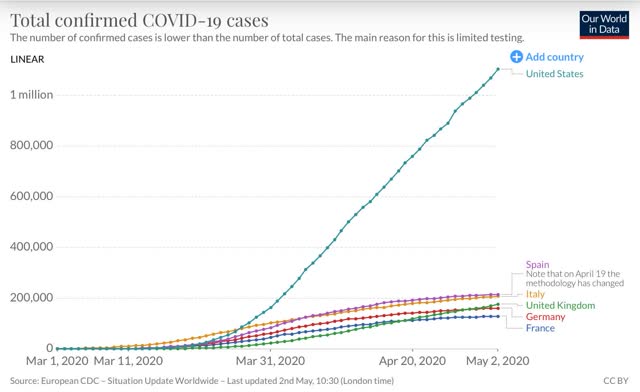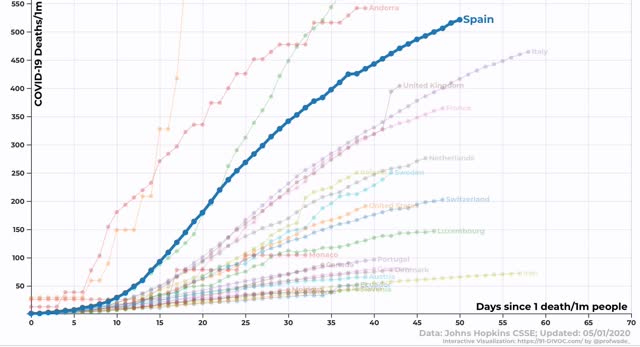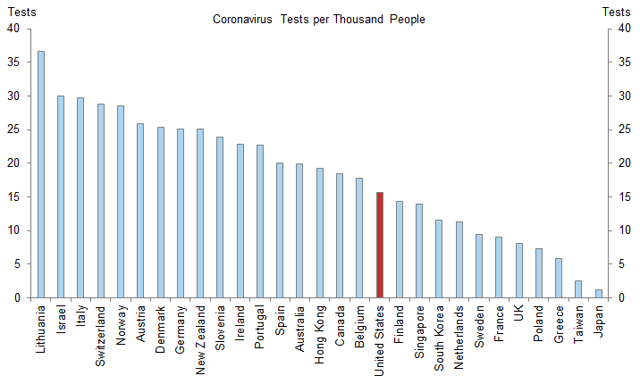Western Europe is a reasonable peer group of countries against which to compare the US response to coronavirus. The 5 largest countries in Western Europe in particular – in order, Germany, the UK, France, Italy, and Spain – together have a population of about 324 million, vs. 332 million for the US.
So let’s take a look at this peer group of European States vs. the United States in terms of cases, deaths, and testing.
One significant difference is that Italy was among the first countries struck in force by the pandemic. In early March it was common to note that the US was “two weeks behind Italy” in the number of cases. The other four all saw their pandemics start a few days to one week ahead of the US. To accomodate that, the below calculations compare each country 58 days after they reached 100 cases nationwide.
As of yesterday, according the Covid Tracking Project, the US had 1,104,161 cases, or 18.7% more than the 5 big Western European States, which had a combined total of 930,231:

When we look at cases per 1 million people, the US is closer to the middle of the pack. In the graph below, aside from city-States like Andorra and San Marino, the US had fewer cases per capita than Spain, and slightly fewer than Italy, but more than the UK, France, or Germany. It also had fewer than Iceland, Belgium and Switzerland, but is on track to overtake Switzerland and Italy within the next few days [NOTE: the two graphs below highlight Spain, which has the worst record among the 5 Western European countries. The US is shown in tan]:

When we look at deaths per million, the US fares better. Among the 5 major States of Western Europe, only Germany has fewer deaths per million:

Germany has only 6,736 deaths, or less than 1 per 10,000 people, a stellar record. This is a tribute to the level of care rendered by the US medical system (note I said “level of care,” not the system itself).
Finally, turning to testing, the US had been languishing near the bottom of the pack, but with the big increase of the last 10 days, it is now closer to the middle of the pack, although it is still below the median:

Note that several places, in particular South Korea and Taiwan, which “crushed the curve” early, have recently had less need for testing.
In summary, compared with its peer group in Western Europe, the US does better than every major country except Germany in terms of care rendered to patients infected by coronavirus, but lags considerably against the better countries in terms of testing, and is among the worst countries for preventing the overall spread of the disease among the population.





I don’t believe the US death statistics. I want to see excess death statistics.
Washington (CNN)The Trump administration will not implement the Centers for Disease Control and Prevention’s 17-page draft recommendation for reopening America, a senior CDC official confirmed to CNN Thursday.
The guidance provided more detailed suggestions beyond the reopening guidelines the administration had put forth last month, including specific suggestions for schools and churches. President Donald Trump in recent days has emphasized the need to quickly reopen the American economy despite public health officials’ urgings for a more cautious approach.
A senior CDC official confirmed to CNN Wednesday night that it was clear that the White House was not going to implement their 17-page draft recommendation for reopening America — after it asked for it. The White House’s decision to not use the guidance was first reported by The Associated Press.
“We are used to dealing with a White House that asks for things and then chaos ensues. A team of people at the CDC spent innumerable hours in response to an ask from Debbie Birx,” said the source.
“The 17-page report represents an ask from the White House Task Force to come up with these recommendations. That’s our role. To put together this guidance.”
A task force official told CNN that Trump’s guidelines announced in mid-April for reopening the country “made clear that each state should open up in a safe and responsible way based on the data and response efforts in those individual states.”
An administration official told CNN that CDC leadership had not seen the draft document before it was leaked, and there were two concerns when it reached the task force. It was “overly prescriptive” because “guidance in rural Tennessee shouldn’t be the same guidance for urban New York City,” and the recommendations in the document did not fit the “phases” that had already been outlined by the task force.
The task force asked for the document to be sent back to the CDC for revisions, which weren’t returned. The administration official didn’t know whether there was a decision at CDC level to shelve the idea.
A senior administration official added that the draft document was the subject of heated internal debate, but ultimately, members of the task force felt it was too specific and might not be helpful as nationwide guidance.
The draft document included specific guidance for six categories: child care programs; schools and day camps; communities of faith; employers with vulnerable workers; restaurants and bars; mass transit administrators. For each category, the draft document notes reopening in phases.
But the White House has been subject to an intensive lobbying effort from certain sectors that were looking to influence the guidelines, the senior CDC official said. And Trump publicly signaled last week that he was unlikely to sign off on guidelines that recommended a return to an altered way of life.
“I see the new normal being what it was three months ago. I think we want to go back to where it was,” Trump said at a meeting with representatives from the restaurant and hospitality industries.
“I want to go back to where it was, that’s where we’re going to be,” Trump said.
At the White House briefing on Wednesday, White House press secretary Kayleigh McEnany reiterated the White House’s initiative to let the nation’s governors implement their own guidelines.
“This is a governor-led effort. The President has said that governors make the decisions as to move forward and we encourage them to follow our phased approach,” McEnany said.
The decision to reject the CDC’s guidance is part of the ongoing friction that has gone on between the top US health agency and the White House, the agency official said. The CDC is trying to get its recommendations implemented at the state level via state agencies.
Part of the debate over the recommendation had to do specifically with what was recommended for businesses.
“The CDC, the White House task force and White House principles were in disagreement on how strongly a public health response should still be in place,” said the official.
The official added that the agency was told by Department of Labor officials — who are all part of the government process — that under the agency’s proposed guidelines, some of the restrictions that would have to be placed on entities like churches and businesses were too stringent, and businesses would be left vulnerable to legal liability if a worker contracts or dies from Covid-19 on the job.
“In the absence of law, it’s regulation, and in the absence of regulation, it’s recommendations. They think it’s left too much open to be interpreted by the courts if something happens on the job. It doesn’t matter if (the Occupational Safety and Health Administration) is playing ball or not,” the CDC source said.
Obama says White House response to coronavirus has been ‘absolute chaotic disaster’